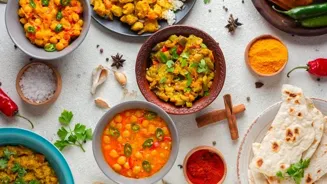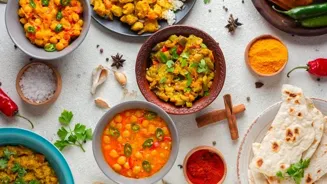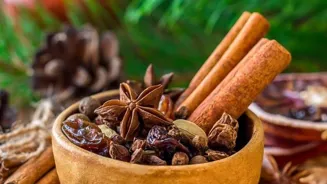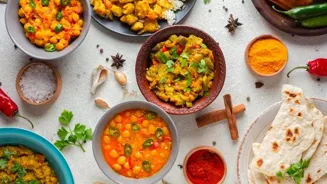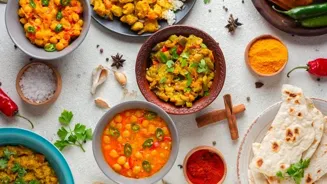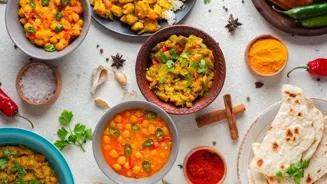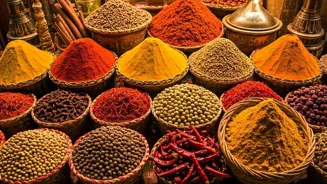Unlock the secrets of Indian cuisine's flavor symphony! Dive into the art of balancing sweet, spicy, and savory notes
Indian cuisine, a tapestry woven with vibrant colors, fragrant spices, and centuries
of culinary tradition, is far more than just a collection of recipes. It's an art form, a delicate dance of flavors where sweet, spicy, and savory notes intertwine to create a symphony on the palate.
The magic lies not just in the ingredients, but in the meticulous balance achieved by the cook, a skill honed through years of experience and a deep understanding of the interplay between these fundamental tastes.
This article delves into the secrets behind achieving this harmonious blend, exploring the techniques and ingredients that make Indian food so uniquely satisfying. It's about more than just following a recipe; it's about understanding the soul of Indian cooking.
Balancing flavors with spices for complex dishes
The cornerstone of this balancing act is the intelligent use of spices. They are not merely added for heat or a pungent aroma, but carefully chosen and combined to create layers of flavor.
Turmeric, with its earthy notes, might be paired with the subtle sweetness of coriander and the fiery kick of chili. A pinch of asafoetida can add a savory depth, while a touch of ginger can lend a warm, comforting spice.
The key is to understand the individual character of each spice and how it contributes to the overall flavor profile. This knowledge allows the cook to adjust the proportions, creating a dish that is both complex and satisfying.
The art lies in achieving a perfect equilibrium, where no single flavor overpowers the others, but rather they complement and enhance each other.
Sweetness balances Indian cuisine flavors subtly
Sweetness, often underestimated in Indian cuisine, plays a crucial role in balancing the heat and savory notes. It can be introduced in subtle ways, through the natural sugars in vegetables like onions and tomatoes, or through the addition of jaggery, dates, or even a touch of honey.
The sweetness doesn't necessarily need to be overtly prominent; it can simply be a gentle undercurrent that softens the edges of the spices and rounds out the overall flavor. Think of the mild sweetness in a dal, which counteracts the earthiness of the lentils and the sharpness of the spices.
Or consider the use of a few raisins in a vegetable pulao, adding a burst of sweetness that complements the savory rice and spices. This subtle inclusion elevates the dish from simple to sublime.
Indian savory cuisine: lentils, veggies, dairy for rich, balanced flavors
Savory elements in Indian cooking stem from a variety of sources, including lentils, vegetables, and dairy products. The umami-richness of lentils provides a hearty foundation for many dishes, while vegetables like potatoes, cauliflower, and eggplant contribute their unique flavors and textures.
Dairy products, such as yogurt and paneer, add a creamy richness and a tangy counterpoint to the spices. The careful selection and preparation of these ingredients are crucial to achieving a balanced savory flavor.
Roasting vegetables can intensify their natural sweetness and depth of flavor, while cooking lentils to the perfect consistency ensures that they are neither too mushy nor too firm. The skillful combination of these savory elements creates a robust and satisfying dining experience.
Indian cooking techniques: tempering and slow cooking for flavor harmony
The techniques used in Indian cooking also play a significant role in achieving balance. The process of "tempering," where spices are fried in oil or ghee before being added to a dish, is a common example.
This technique releases the essential oils in the spices, enhancing their aroma and flavor, and infusing the dish with a deeper complexity. Similarly, the method of slow cooking allows the flavors to meld together over time, resulting in a more harmonious and well-rounded dish.
Whether it's simmering a dal for hours or roasting vegetables at low temperatures, these techniques require patience and attention to detail, but the results are undeniably worth the effort.
The goal is to coax the best flavors out of each ingredient and to allow them to interact in a way that creates a truly unforgettable culinary experience.
Indian cooking: a blend of sweet, spicy, savory flavors, showcasing creativity and tradition
Ultimately, the art of balancing sweet, spicy, and savory flavors in Indian cooking is a testament to the ingenuity and creativity of Indian cooks.
It's a skill that is passed down through generations, refined through practice, and informed by a deep understanding of the ingredients and techniques involved. While there are general principles to follow, there's also room for experimentation and personal expression.
Each cook brings their own unique touch to the dish, adjusting the proportions and techniques to create a flavor profile that reflects their own palate and preferences.
This is what makes Indian cuisine so diverse and exciting, a constantly evolving art form that continues to delight and inspire food lovers around the world. It's an open invitation to explore, experiment, and discover the magic of balanced flavors.
AI Generated Content. Glance/InMobi shall have no liability for the content